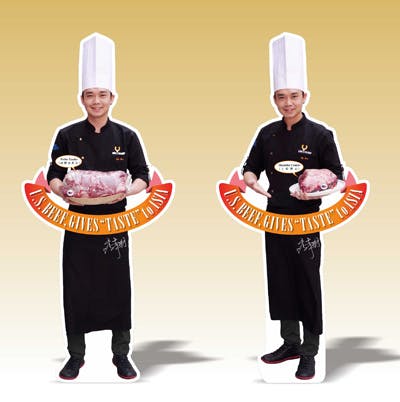New Cuts Key to Sustaining U.S. Beef Growth in Taiwan

Celebrity Chef Pan holds two U.S. beef dishes in this point-of-sale display
Taiwan’s love for American beef is evident by the growth in exports to the Asian island nation this year, and USMEF-Taiwan’s team is exploring new channels to sustain that progress.
Australian beef has held an edge in Taiwan in recent years, and beta agonist concerns in 2012 further challenged U.S. beef sales, but persistent cultivation of Taiwanese importers and merchants by USMEF has helped reverse that trend, winning new converts to the taste and value of grain-fed American beef.
Looking to sustain that momentum, USMEF recently held a seminar for about 75 restaurant and hotel foodservice professionals to introduce them to new cuts of U.S. beef while providing them background on food safety, product handling and business operations. The program was conducted with support from the USDA Market Access Program (MAP) and the Beef Checkoff Program.
The audience included recipients of USMEF’s Platinum U.S. beef certification – 5-star hotels and restaurants that sign a contract stating that they offer either prime or choice U.S. beef, buy products from certified importers, label them as U.S. beef, and source a minimum of 50 percent of their beef from the United States.
The petite tender and the clod heart were the center of attention at the two-day seminar where Chef Chiang, executive chef from the Hotel Royal Chiao His, demonstrated different menu applications for the two cuts to give food service operators options to offer their customers.
“It is very wise and strategic by USMEF to provide some middle-priced products for the Taiwan market,” said a senior executive from Chez Jimmy restaurant, who noted that the restaurant chain has begun selling petite tenders as steaks, and is hoping to see new cuts offered as consumers are increasingly embracing U.S. beef.

Taiwanese chefs get a close-up look at U.S. beef cuts
Seminar participants enjoyed the taste and juiciness of the petite tender, indicating that they likely would serve it either as a steak or in yakiniku dishes.
The clod heart also was welcomed by the chefs, who said they would use it in hot pot dishes, serve it pan-grilled or as roast beef, or use it for further processing. The general manager of HaurYang Enterprise indicated that based on the seminar, he would recommend the clod heart to his customers.
The seminar also included information on food safety practices and business practices including customer service and staff education.
With only a 5 percent domestic self-sufficiency in beef, Taiwan relies heavily on imports to meet the needs of consumers. Last year, the U.S. was a distant third behind Australia and New Zealand in beef sales to Taiwan, both in terms of volume and value, as Australia held a 47 percent market share to New Zealand’s 18 percent and nearly 15 percent (volume) for the U.S. – 17.5 percent in terms of value, according to the Global Trade Atlas.
This year, U.S. beef has made great strides in regaining lost market share in Taiwan. Through the first nine months of 2013, sales of U.S. beef have grown nearly 214 percent in value to $199 million, taking 41 percent market share versus 34 percent for Australia and 20 percent for New Zealand.
Australia still holds an edge in terms of volume – 38.5 percent versus 32 percent for the U.S. and 21 percent for New Zealand, but American beef sales have grown 159 percent year-over-year while the top competitors have seen their shares fall.
“We will continue to introduce new offerings to buyers in Taiwan so that they will understand that there are options for different cuisines and different menu price points,” said Davis Wu, USMEF-Taiwan director. “We have many friends in Taiwan who love and support U.S. beef. It is a long-term relationship that we will continue to cultivate.”
